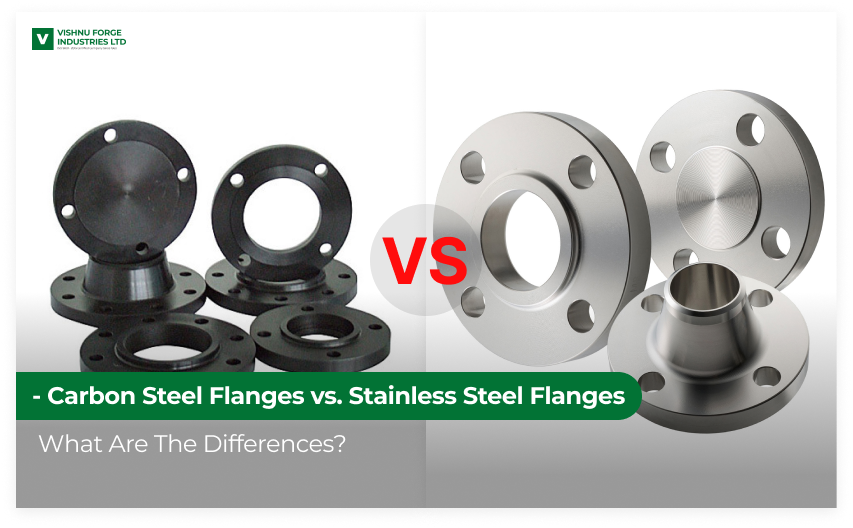In the realm of industrial applications, the choice of materials is crucial for ensuring optimal performance and durability. With regards to flanges, the decision to use carbon steel or stainless steel can have a significant impact on various factors such as reliability, cost, and suitability for specific environments. In this article, we will delve into the differences between carbon steel flanges and stainless steel flanges, exploring their composition, key features, as well as the pros and cons associated with each material.
Understanding the Basics of Flanges
What are Flanges?
Flanges are essential components used in piping systems to connect sections of pipe or equipment together. They provide a means for easy assembly and disassembly, allowing for efficient maintenance and repairs. In addition to their functionality, flanges also play a crucial role in ensuring the integrity and safety of industrial operations.
Importance of Flanges in Industrial Applications
Flanges by Forging Manufacturers In Bangalore act as a connection point between various components, such as pipes, valves, and fittings, in a piping system. Their primary function is to provide a leak-proof joint, preventing fluid or gas leakage that could lead to hazardous situations or compromise the efficiency of the system. Flanges also facilitate alignment and support the weight of piping components, ensuring stability and minimizing stress on the system.
Moreover, flanges come in a variety of materials to suit different applications and environments. Common materials used for flanges include carbon steel, stainless steel, and alloy steel. The choice of material depends on factors such as the type of fluid or gas being transported, temperature, pressure, and corrosion resistance requirements. For example, stainless steel flanges are preferred for applications where corrosion is a concern, while carbon steel flanges are suitable for high-temperature and high-pressure environments.
Furthermore, flanges by Forging Manufacturers In Bangalore are available in different types and facing configurations to meet specific project requirements. The most common types of flanges include weld neck, slip-on, socket weld, lap joint, and blind flanges. Each type has its unique design and application, with weld neck flanges being ideal for high-pressure applications due to their welded connection, while slip-on flanges are easier to align and install. Additionally, flange facing, such as raised face, flat face, and ring-type joint, plays a crucial role in ensuring proper sealing and alignment between flange components.
Diving into Carbon Steel Flanges
Composition of Carbon Steel Flanges
Carbon steel flanges are primarily composed of iron and carbon, with small amounts of other elements such as manganese, silicon, and copper. The carbon content in carbon steel flanges typically ranges from 0.05% to 2.1%, depending on the grade. The presence of carbon enhances the strength and hardness of the flanges, enabling them to withstand high-pressure and high-temperature environments.
When it comes to the composition of carbon steel flanges, the inclusion of other elements plays a crucial role in determining their specific properties. Manganese, for instance, improves the hardenability and tensile strength of the flanges, making them even more resilient. Silicon, on the other hand, enhances the flanges’ resistance to oxidation and corrosion, adding an extra layer of protection.
Key Features of Carbon Steel Flanges
Carbon steel flanges exhibit excellent mechanical properties, including high tensile strength and good ductility. This makes them well-suited for applications that involve heavy-duty operations or exposure to harsh conditions. Moreover, carbon steel flanges by Forging Manufacturers In Bangalore offer good resistance to corrosion, especially when coated or galvanized.
Another notable feature of carbon steel flanges is their versatility. They can be easily welded, allowing for convenient installation and modification. This flexibility makes carbon steel flanges a popular choice across various industries, including oil and gas, chemical processing, and power generation.
Pros and Cons of Using Carbon Steel Flanges
One of the significant advantages of carbon steel flanges is their cost-effectiveness. Comparatively, they are generally more affordable than stainless steel flanges. Additionally, carbon steel flanges are known for their durability, as they can withstand extreme conditions and demanding applications.
However, it is important to note that carbon steel flanges are susceptible to corrosion in certain environments, particularly when exposed to moisture or chemicals. Therefore, proper maintenance and protection measures, such as regular inspections and the application of protective coatings, should be implemented to mitigate the risk of corrosion.
Furthermore, it is worth mentioning that carbon steel flanges come in various grades, each with its own unique properties and applications. The selection of the appropriate grade depends on factors such as the specific operating conditions, the required strength, and the level of corrosion resistance needed.
In conclusion, carbon steel flanges by Forging Manufacturers In Bangalore are a reliable and cost-effective choice for many industrial applications. Their composition, key features, and pros and cons make them a versatile option that can withstand demanding conditions. By understanding their properties and taking proper maintenance measures, carbon steel flanges can provide long-lasting performance and contribute to the success of various projects.
Exploring Stainless Steel Flanges
Stainless steel flanges by Forging Manufacturers In Bangalore are an integral component in various industries, providing a reliable and durable solution for connecting pipes or valves. With their exceptional corrosion resistance properties and aesthetic appeal, stainless steel flanges have become a popular choice for applications where both functionality and visual appearance matter.
Composition of Stainless Steel Flanges
Stainless steel flanges are composed of iron, chromium, and varying amounts of other elements such as nickel, manganese, and molybdenum. The addition of chromium provides stainless steel flanges with excellent corrosion resistance properties, making them suitable for applications where exposure to moisture or aggressive chemicals is a concern. This unique composition ensures that stainless steel flanges can withstand harsh environments and maintain their structural integrity over time.
Key Features of Stainless Steel Flanges
Stainless steel flanges are renowned for their remarkable corrosion resistance. They not only resist rust and staining but also exhibit exceptional strength, even in high-temperature and high-pressure environments. This makes stainless steel flanges a reliable choice for industries such as oil and gas, chemical processing, and marine applications, where reliability and durability are paramount.
Moreover, stainless steel flanges possess superior aesthetic appeal, adding a touch of elegance to any piping system. Their smooth and polished surface finish not only enhances their visual appeal but also facilitates easy cleaning and maintenance.
Pros and Cons of Using Stainless Steel Flanges
One of the primary advantages of stainless steel flanges by Forging Manufacturers In Bangalore is their corrosion resistance. They are highly resistant to rust and staining, ensuring longevity and minimizing the need for frequent maintenance or replacement. This makes them an excellent choice for industries such as food processing, pharmaceuticals, and water treatment, where hygiene and cleanliness are of utmost importance.
However, it is worth noting that stainless steel flanges tend to be more expensive than carbon steel flanges. This is primarily due to the higher cost of the materials used in their composition, as well as the specialized manufacturing processes involved. Despite the higher initial investment, the long-term benefits of stainless steel flanges, such as their extended lifespan and reduced maintenance costs, often outweigh the upfront expenses.
Another consideration is the strength of stainless steel compared to carbon steel. While stainless steel flanges offer excellent strength and reliability, they may not be as suitable for certain high-stress applications where carbon steel’s superior strength is required. It is crucial to assess the specific requirements of the application and consult with industry experts to determine the most appropriate flange material.
In conclusion, stainless steel flanges are a versatile and reliable choice for various industries, offering exceptional corrosion resistance, strength, and aesthetic appeal. While they may come at a higher cost and have certain limitations, their numerous advantages make them an excellent investment for applications where durability and performance are paramount.
Comparing Carbon Steel and Stainless Steel Flanges
Durability Comparison
In terms of durability, both carbon steel and stainless steel flanges exhibit excellent performance. However, carbon steel flanges are generally more robust and can withstand extreme conditions better than stainless steel flanges. The corrosion resistance of stainless steel flanges may be superior, but their strength might be compromised under intense stress or high-temperature environments.
Cost Comparison
Cost is often a critical factor when selecting between carbon steel and stainless steel flanges. Carbon steel flanges are typically more affordable than stainless steel flanges due to the lower cost of raw materials and manufacturing processes involved. If budget constraints are a concern, carbon steel flanges may be a more viable option.
Application Comparison
The choice between carbon steel and stainless steel flanges by Forging Manufacturers In Bangalore depends on the specific application requirements. Carbon steel flanges are commonly used in industries such as oil and gas, petrochemical, and power generation, where strength, reliability, and cost-effectiveness are crucial. On the other hand, stainless steel flanges find extensive use in industries such as food processing, pharmaceuticals, and chemical processing, where resistance to corrosion and hygiene play a significant role.
When it comes to carbon steel flanges, their high tensile strength makes them ideal for applications that involve heavy loads and high-pressure environments. These flanges can withstand extreme temperatures, making them suitable for use in industries where heat resistance is paramount. Additionally, carbon steel flanges have excellent impact resistance, ensuring their reliability even in harsh operating conditions.
Stainless steel flanges, on the other hand, offer exceptional corrosion resistance, making them a popular choice in industries where exposure to chemicals, moisture, and other corrosive elements is common. Their non-reactive nature ensures that the integrity of the flanges is maintained, preventing contamination and ensuring the safety of the product or process. Furthermore, stainless steel flanges are known for their aesthetic appeal, making them suitable for applications where visual appearance is important.
In conclusion, selecting the right material for flanges by Forging Manufacturers In Bangalore is essential for achieving optimal performance and longevity in industrial applications. Carbon steel flanges offer durability and cost-effectiveness, while stainless steel flanges provide superior corrosion resistance and aesthetic appeal. The decision between carbon steel and stainless steel flanges ultimately depends on the specific requirements of the application at hand. By considering factors such as environmental conditions, operating pressures and temperatures, and budget constraints, industry professionals can make informed choices to ensure the success of their projects.



